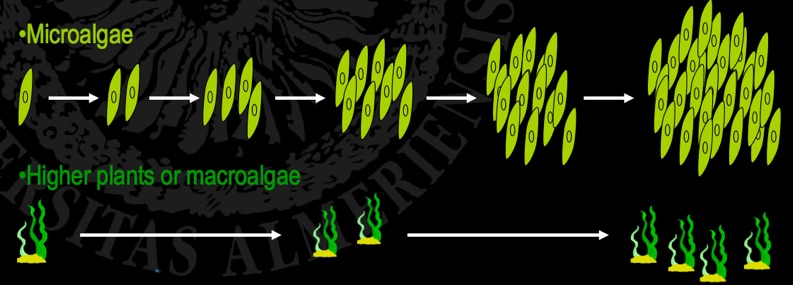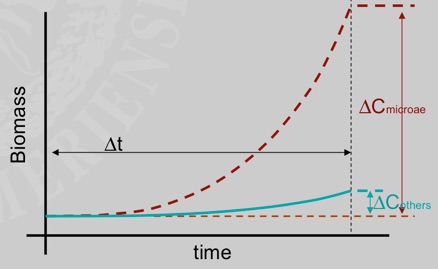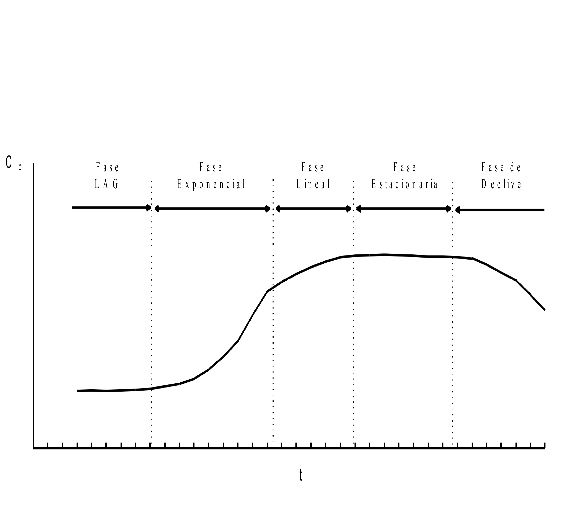2. Microalgal Growth Kinetics.


2.1. Microalgae and cyanobacteria are the among the fastest-growing phototrophs.
Microalgae, cyanobacteria and in general unicellular phototrops, are fast-growing microorgaisms or, to be more precise, they are fast-duplicating organisms with a great potential to generate biomass at a high rate as compared to other higher, pluricelular photosintetic organisms. The reason for this is that to start reproducing, microalgae do not need to grow leaves, stalks and flowers or whatever reproductive organs. They are ready to reproduce again within hours.
Questions:
-
• Relate the concept of specific growth rate to the duplication time.
-
• Can µ be calculated using decimal logaritms and en base 10 exponential function?
-
• You observe that a culture loses 12% of it biomas during the night (10 hours). What is the maintenance rate of such culture?
-
• Name a few other culture factors that can lead to cell damage and thus increase the death rate.

This is
-
•Their reproduction time (properly duplication time) is short.
-
•Thus, their growt rate is high.
-
•They show a very high phosynthetic efficiency.
-
•And many other advantages such as not needing a soil to grow.
We will not dicuss the reproduction mechanisms. Being this an engineering-oriented subject, we will treat microalgal growth as a black-box and let the phycologists deal with such details.
What we do know is that microalgae reproduce soon and thus grow fast. This is translated to math concepts in the following picture:


This relationship between the biomass concentration, Cb, with time, t, allows defining the following concepts:
Specific growth rate, µ:
And biomass productivity:
Both are defined instantaneously (dt) although also make sense defined in a finite time interval, as shown in the picture.

When the microorganism grows unrestrained by nutrien limitations or the accumulation of waste products, the specific growth rate is maximum (for the temperature set) and the differential definition of specific growth rate integrates to:
In case you do not already know, specific growth rate quantifies growt potential as a number that indicates how many times a organism reproduces in the time unit. Hence its dimension of 1/time. On the other hand, the productivity is:
Which, as you can check for yourself, its an extremely fast-growing function. Its units are biomass generated in the unit time and per unit of culture volume (eg. kg biomass per m3 and s in the IS).
Of course this unlimited-growth phase ends soon and the culture becomes nutrient-limited. A culture typically goes trough the following phases:
-
•The unlimited phase is called, quite unsurprisingly, the exponential phase.
-
•The lag phase is typically observed when a culture has just been started and the microoganisms are adapting to the new environmental conditions.
-
•You will find a linear phase when growth is limited by a nutrient that is difficoult to transfer to the culture (such as oxygen in bacterial or yeast cultures or light for microalgae) and is consumed as arrives at a constant rate.
-
•Finally, the environment degradates and the death rate increases equals the growth rate and even becomes greater.
The nutrient limitation that is characteristic of microalgae is light limitation.


-
•Basic concepts

-
•Light-limited microalgal growth
In a light-limited culture, all limitations but light availability have been eliminated.
After the culture has been optimized for T, pH and nutrient concetration, we have:
The equations relating µ and I are called light limitation growth models. We will be seeing some of those in the rest of the lesson as we will need them to understand microalgal growth in dense cultures and for photobioreactor optimization.


-
•Some additional concepts you may already be familiar with.
You probably know these, but I am putting them there for the sake of clarity
Net and Gross growth rate and the concept of maintenance.
The net growth rate is the one observed, but the fixation of light energy can be susbstantially higher. The reason for this is that a part of the energy/biomass is used for maintenance:
µgross is a much realistic indicator of the metabolic activity. To obtain it from µnet me must meassure m. Tis is easily done by turning of the light and meassuring the course of evolution of Cb with time.
That can be calculated from:
Death rate and culture age.
Death rate also represents a loss of biomass but in this case biomass does not dissapear (at least instantaneously) although it certainly stops contributing to the biomass growth and should not be included in in the definition of specific growth rate.
Death rate is closely related to the culture age which is difficult to characterize because cells of a different range of ages cohexist.
In a batch culture the cummulative age distribution depends on the culture time while in a continuous culture this is given by the Residence Time Distribution function (RTD).
Using any of those age distributions, it is possible to assign a maximum age to any given strain a decide that all the cells over that age are dead.
It is difficult to find data on the death age of microalgae under specific culture conditions.
On the other hand, it is possible to measure the proportion of death cells in a culture and from that infer the death rate and even the death age
For the time being we will ignore the death rate but we will see how to deal with is if necessary in Lesson 6, industrial photobioreactor optimization.







